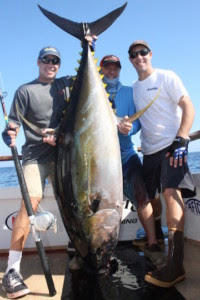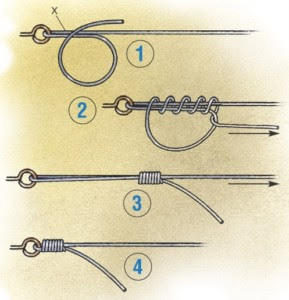Good Knots are Key to Great Catches
By Ben Secrest, Accurate Fishing
from The Fishing Wire

Yellowfin Tuna
The right knots help land fish of a lifetime. This 256 lb. yellowfin is the perfect example for Team Accurate.
The attention to detail in daily life helps all of us moving forward to succeed in obstacles we face everyday. The whole adventure of fishing is based on some details that once summed up can lead to successfully landing or losing the fish of a lifetime.
One extremely important part of everyday fishing is being able to tie knots that will withstand the test of a gamefish during the heat of a lengthy battle. We wanted to show you some basic knots that will help you during your fishing adventures no matter if its at the lake, inshore along the coast or targeting larger gamefish offshore. Many of the knots are common in all fishing circles from super light line to heavy duty offshore fishing–they are proven. Here are some of the well known knots that you should become familiar with for your time on the water.

Clinch Knot
Clinch Knot is used to tie a hook, swivel, or lure onto your line. This clinch has been a staple knot among salt and freshwater anglers for years. This knot will work on monofilament or braided lines. When tying the knot make sure you cinch it tight using water or saliva to avoid any friction on the line. Tie the knot correctly and make sure you cinch it down by pulling securely on the running line. Once cinched then trim tag end.

Parlomor Knot
Palomar knot Palomar has been a very popular knot among fishermen for securing their line to a hook. Its a very easy knot to tie and extremely strong. This knot works very well with monofilament and braid. There are variations of this knot out there and all work well if tied properly. Again lubricating the mono line helps reduce friction and it is extremely important to cinch the knot and trim tag end after.

Uniknot
UniKnot is well proven in all circles as easy to tie and can be used with heavier test line. This knot has been a main stay of lots of anglers including myself. I use it to tie on hooks, lures, swivels, and pretty much anything that requires a sound knot. When using lighter line I double the line through the eye of the hook and then tie a uniknot which gives you more strength at the eye of the hook. The thing about a unknot is when it cinches down right it’s square on the hook. Very solid.

Loop Knot
Loop knot is a popular knot among the artificial plug fishermen where a loop on the lure will elicit more action in the lure during certain retrieves. These knots are good but the thing to remember if you are going to fight gamefish for any length of time is that the loose line of the loop on the eye of the bait will wear overtime and often break. Catch a couple fish and check it for any frays to make sure you are solid.

Surgeon Knot
Surgeons Knot is a double line knot for anglers looking for double the strength of their line or knots. It is also used to attach double line leaders. People use the bimini knot or the surgeons loop to attach leaders loop to loop. Very important to cinch it square or it will wear on itself.

Double Uniknot
Double Uniknot is one of the easy knots to tie and extremely reliable from two pound test to 100 lb. Its easy to tie and has a higher breaking strength versus others. This knot is used to tie leader onto your main line or to join two lines. It is a little bulkier going through the guides but is a proven performer for fishermen around the globe.

Albright Knot
Improved Albright Knot is another knot for connecting two lines, running line to leader, that works perfect with mono, floro, or braid. This is a strong knot and very compact so it travels through the guides easier. We have used this knot for years for tying 30lb mono and to 100 to 150 lb leader material for casting rigs for stripe marlin here on the west coast. Fairly easy knot to tie once you practice it but like any knot make sure it is cinched prior to trimming any tag lines. The braid to floro leader works like magic. Remember with braid take more wraps so the knot lays right.

Pena Knot
Tony Pena Knot works very well with mono to mono but it is the strongest of the knots we use for braid to mono/floro connections for poppers, surface lures, and baits for larger tunas. It is a very basic knot and probably the strongest we have used for leader to braid connection. With smaller lines we tie a 2 to 3 turn uni-knot for the overhand knot then ten up and ten back with the braid then through the loop. These knots push against each other when cinching and square up nicely. The knot goes through the guides well and is very easy to cast with minimal hang up in the guides. We have tied this knot exclusively for the last few years for our popper rigs with conventional gig with 65 or 80 lb braid to 100 or 130 lb floro leader. Very strong, dependable knot when tied correctly and fully cinched. Proven with the west coast tuna guys.
All these knots have good ratings among anglers. Whatever you have the most confidence in tie. I have been tying the same knots for years and I have changed a couple knots along the way. Key to any knot is tie it correctly and most important thing is lubricate your line, cinch your knot, then trim tag end. Never trim the tag end until you cinch your knot. The knot is the very base to be successful catching fish. To be good at anything, you need to practice what is involved. Its the same with tying knots. While watching TV practice your knots. Get them right and they will help you produce that fish of a lifetime
Team Accurate
By Ben Secrest|